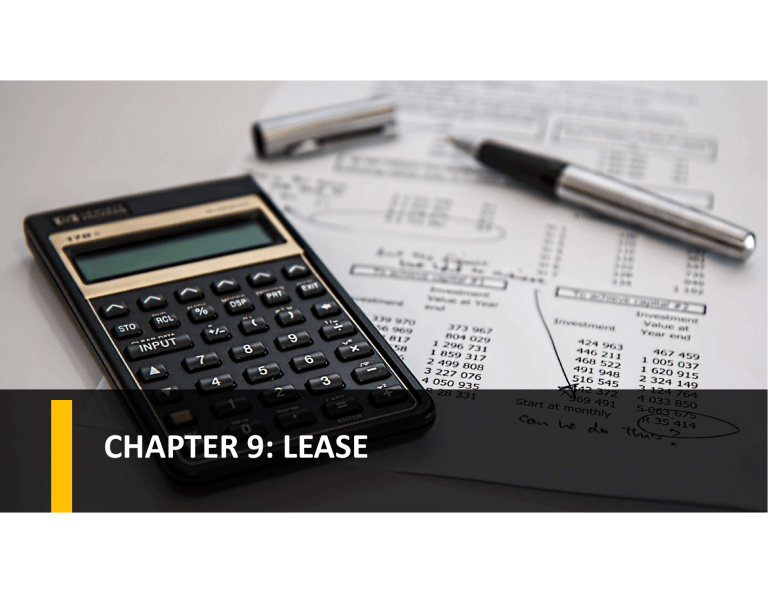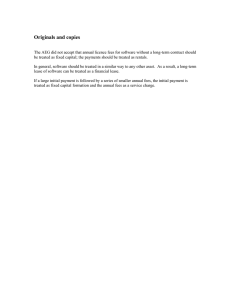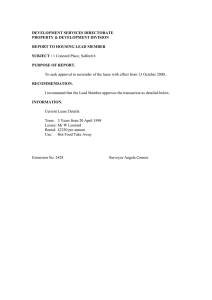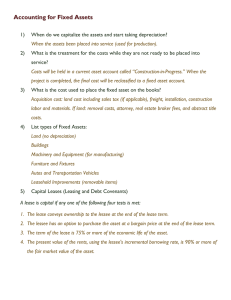
CHAPTER 9: LEASE
Learning objectives
• Account for right of use assets and lease liabilities in the records of the lessee
• Explain the exemption from the recognition criteria for leases in the records of the lessee
• Account for sale and leaseback agreements
OVERVIEW
Lease: A contract, or part of a contract, that conveys the right to use an asset (the underlying asset) for a period
of time in exchange for consideration.
Co. B
Co. A
RENTAL PAYMENTS
•
•
Legally owns the assets
Lessor
Advance – start of the lease period
Arrears – end of the lease period
Uses the assets
Lessee
• Right of use asset
• Lease liability
OVERVIEW
OVERVIEW
Terminologies
Identify a lease?
An entity must identify whether a contract contains a lease, which is the case if the contract conveys
the right to control the use of an identified asset for a period of time in exchange for consideration.
RIGHT TO CONTROL
IDENTIFIED ASSET
Entity must have the right to:
• Obtain substantially all
economic benefits from the
use of asset
• Stated in the contract
• May be a part of a larger asset
• The lessor has no substitution
rights (a similar asset cannot
be used instead of the original
leased asset)
• Direct the use of the asset
PERIOD OF USE
• Period of use in time
Identify a lease?
Is there an
identified asset?
NO
YES
Does the lessee
obtain
substantially all
the economic
benefits?
YES
Does the lessee
have the right
to direct use of
the asset?
NO
The contract does not contain a lease; apply other applicable IFRSs
NO
YES
Contract
contains a
lease
Identify a lease
Coketown Council has entered into a five-year contract with Carefleet Co, under which Carefleet Co supplies the council with ten
vehicles for the purposes of community transport. Carefleet Co owns the relevant vehicle, all ten of which are specified in the
contract. Coketown Council determines the routes taken for community transport and the charges and eligibility for discounts.
The council can choose to use the vehicles for purposes other than community transport. When the vehicles are not being used,
they are kept at the council's offices and cannot be retrieved by Carefleet Co unless Coketown Council defaults on payment. If a
vehicle needs to be serviced or repaired, Carefleet Co is obliged to provide a temporary replacement vehicle of the same type.
Lessee:
Coketown
IDENTIFIED
ASSET
Identifiable asset - the ten vehicles specified in the contract
Carefleet Co does not have the right to substitute any of
the vehicles unless they are being serviced or repaired
RIGHT TO
CONTROL
council has a right to use the vehicles for the period of the
contract
PERIOD OF
USE
five-year contract with Carefleet Co
Recognise in its SOFP:
1. Right-of-use asset
2. Lease liability
Lessee accounting
Recognition & measurement
RIGHT-OF-USE
ASSET
(AT COST)
LEASE
LIABILITY
(Present value
of lease
payments)
Under IFRS 16, There is no longer a distinction between finance lease and operating lease, as the lessee controls the
leased asset during the lease term, and is recognized an asset and a liability respectively. (recognized under the
previous standard's finance lease method)
Lessee accounting
Recognition & measurement
A lessee may elect to account for lease payments as an expense (like operating lease under IAS 17) on a straightline basis over the lease term or another systematic basis for the following 2 types of leases
Lessee accounting
Initial measurement
To calculate the initial value of the
liability and right-of-use asset, the
lessee must consider the length of
the lease term. The lease term
comprises:
• Non-cancellable periods
• Periods covered by an option to
extend the lease if reasonably
certain to be exercised
• Periods covered by an option to
terminate the lease if these are
reasonably certain not to be
exercised.
+ Lessee’s incremental borrowing rate: represent what the lessee ‘would have to
pay to borrow over a similar term and with similar security, the funds necessary to
obtain an asset of similar value to the right-of-use asset in a similar economic
environment
Lessee accounting
At the beginning of the year 20X6, Tusco signed into a three-year contract to lease a lorry. The contract contains an
option to extend for one more year. Tusco believes that they will use this option. Lorries have a useful economic life of 8
years. Lease payments are $16,000 per year for the initial term and $20,000 per year for the option. All payments are
due at the end of the year. To obtain the lease, Tusco paid initial payment of $4,000. X’s incremental rate of borrowing is
5%.
Calculate the initial carrying amount of the lease liability and the right-of use asset of Tusco for this contract
Lessee accounting
Step 1: Identify exactly lease term
Step 2: Calculate lease liability
Lease liability = Total value of annual payment (in each term of lease) × Discount rate
Discount rate = 1/(1+r)y
• r: implicitly rate
• y: time period from year 1 to the year-end of the lease term
Step 3: Calculate right of use asset (according to above theory).
Step 4: Record lease liability and right of use asset.
Lessee accounting
Lessee accounting
Subsequent measurement
Note 1: After initial recognition
• A right-of-use asset will normally be
measured on the cost model
• It can be measured on the revaluation
model if that belongs to an asset group
that should applies revaluation model
under IAS 16, or it is an investment
property under IAS 40.
Note 2: When using cost model to measure a right-of-use asset, we must calculate depreciation as follows:
• If ownership of the asset transfers to the lessee at the end of the lease term then depreciation should be charged over
the asset's useful life
• Otherwise, depreciation is charged over the shorter of the useful life and the lease term.
Lessee accounting
Right-of-use asset
Non-current assets
Lease liability
Current liabilities
Non-current liabilities
Interest charges
Finance cost
LESSEE
SOFP
• ROU assets together
with PPE or as own
line item
• Lease liability (IAS 1)
SOPL
SOCF
• Depreciation of all
leased assets
• Principal within financing
activities
• Interest expense for
all lease liabilities
• Interest within either
operating or financing
activities (IAS 7)
Lessee accounting
ALLOCATION OF FINANCE COST
LESSEE
RENTAL PAYMENT
Interest
portion
Finance charge
(SOPL)
A repayment of
part of the capital
cost of the asset
Debited to the lessor's
account to reduce the
outstanding liability
Lessee accounting
ALLOCATION OF FINANCE COST
1. what proportion of each instalment paid by the lessee represents interest,
2. what proportion represents a repayment of the capital advanced by the lessor
RENTAL
PAYMENT
ACTUARIAL
METHOD
Finance charge
To be allocated to periods during the lease term
using interest rate implicit in the lease
Repayment of
capital
the balance of the payment is the repayment of capital
Lessee accounting
Subsequent measurement
Payment in advance is means
that
rental
made
at
beginning of the lease year
Payment in arrears is
means that rental made at
ending of the lease year
Lessee accounting
PAYMENT IN ADVANCE
Lessee accounting
PAYMENT IN ADVANCE
Lion Co enters into a five-year lease of a building which has a remaining useful life of ten years. Lease payments are
$50,000 per annum, payable at the beginning of each year.
Lion Co incurs initial direct costs of $20,000 and receives lease incentives of $5,000. There is no transfer of the asset at
the end of the lease and no purchase option.
The interest rate implicit in the lease is not immediately determinable but the lessee’s incremental borrowing rate is
5%, with the value of $1 having a cumulative present value in four years' time of $3.546.
The value of $1 has a cumulative present value in five years' time of $4.329.
At the commencement date Lion Co pays the initial $50,000, incurs the direct costs and receives the lease incentives
EXAMPLE – Payment in advance
Step 1 Calculate lease liability
$50,000
Y3
Y2
Y1
0
The lease liability is measured at the present value of the remaining four payments
1
$50,000
$50,000 x $3.546 = $177,298
2
$50,000
Payment
PV
0
50,000
50,000
Y5
Y4
4
$50,000
3
$50,000
1
50,000
47,619
2
50,000
45,351
3
50,000
43,192
$177,298
4
50,000
41,135
5
Total
250,000
227,298
6
EXAMPLE – Payment in advance
Step 2 Calculate value of Right-of-use asset
Dr
$
$
Initial payment
Discounted liability
50,000
177,298
Initial direct costs
20,000
Incentive received
(5,000)
242,298
Right-to-use asset
Cr
$
242,298
Lease liability
177,298
Cash (50 + 20 – 5)
65,000
EXAMPLE – Payment in advance
Lease liability table
Year
Opening
balance
Lease payment
Liability subject to
interest
Interest (5%)
Closing
balance
1
227,298
(50,000)
177,298
8,865
186,162
2
186,162
(50,000)
136,162
6,808
142,971
3
142,971
(50,000)
92,971
4,649
97,619
4
97,619
(50,000)
47,619
2,381
50,000
5
50,000
(50,000)
-
-
-
EXAMPLE – Payment in advance
End of Y1
0
Start of Y2
1
End of Y2
2
2
Current liability
Opening bal
227,298
Lease payment
50,000
41,135 (= 50,000 – 8,865)
Interest
8,865
Y2:50,000
Liability subject
to interest
Interest payable
Principal
177,298
Current
8,865
186,162
Closing bal
Non-Current
Current
Principal
41,135
Non-Current
177,298-41,135
PAYMENT IN Y2
$50,000
Interest Y1
$177,298 at Y1
Principal in Y2
$8,865
Short-term
Long-term
$41,135
$136,162 (bal)
Non-current
liability Y1
$41,135 (bal)
Interest
payable Y1
Short-term Y1
Current
liability Y1
EXAMPLE – Payment in advance
SFP extract
Non-current asset
Fixed asset
Depreciation
$
242,298
(48,460)
Carrying value
193,838
Current liability
Interest payable
8,865
Current liability
$
50,000
Non-current liability
Lease obligations
177,298
Non-current liability
136,163
Short-term lease obligation
41,135
Long-term lease obligation
136,163
SOPL extract
Depreciation
Interest charge
48,460
8,865
186,163
Lessee accounting
PAYMENT IN ARREARS
EXAMPLE – Payment in arrear
Lion Co enters into a five-year lease of a building which has a remaining useful life of ten years. Lease payments are $50,000
per annum, payable at the end of each year.
Lion Co incurs initial direct costs of $20,000 and receives lease incentives of $5,000. There is no transfer of the asset at the
end of the lease and no purchase option.
The interest rate implicit in the lease is not immediately determinable but the lessee’s incremental borrowing rate is 5%,
with the value of $1 having a cumulative present value in four years' time of $3.546.
The value of $1 has a cumulative present value in five years' time of $4.329.
At the commencement date Lion Co pays the initial $50,000, incurs the direct costs and receives the lease incentives
EXAMPLE – Payment in arrear
Step 1 Calculate lease liability
Y3
Y2
Y1
0
The lease liability is measured at the present value of the remaining five payments
1
$50,000
2
0
$50,000 x $4.329 = $216,474
Payment
PV
4
$50,000
3
$50,000
$50,000
-
1
50,000
47,619
Y5
Y4
2
50,000
45,351
3
50,000
43,192
4
50,000
41,135
5
Total
50,000 250,000
39,176 216,474
5
$50,000
6
EXAMPLE – Payment in arrear
Step 2 Calculate value of Right-of-use asset
Dr
$
$
Initial payment
Discounted liability
0
216,474
Initial direct costs
20,000
Incentive received
(5,000)
231,474
Right-to-use asset
Cr
$
231,474
Lease liability
216,474
Cash (20 – 5)
15,000
Example – Payment
Year
in arrear
• Lease liability table
1
2
3
4
5
Opening
216,474
Interest (5%)
10,824
Payment
(50,000)
177,298
8,865
(50,000)
136,162
6,808
(50,000)
92,971
4,649
(50,000)
47,619
2,381
(50,000)
Closing
177,298
136,162
92,971
47,619
-
EXAMPLE – Payment in arrear
End of Y1
0
Opening bal
Interest
1
Start of Y2
2
2
216,474
10,824
Interest Y2
Interest Y1
Payment
End of Y2
50,000
50,000
Principal Y2
Closing bal
177,298
Current liabilitiy
EXAMPLE – Payment in arrear
PAYMENT IN Y1
$50,000
Principal
payable in Y1
Paid Interest Y1
$177,298 at Y1
Short-term
(Current liability)
Long-term
(Non-current liability
$41,135
= 50,000 – 8,865
$136,163 (bal)
EXAMPLE – Payment in arrear
SFP extract
Non-current asset
Fixed asset
Depreciation
$
231,474
(46,295)
Carrying value
185,179
Current liability
Interest payable
0
Non-current liability
Lease obligations
177,298
Short-term lease obligation
41,135
Current liability
41,135
Long-term lease obligation
136,163
Non-current liability
136,163
SOPL extract
Depreciation
Interest charge
$
177,298
46,295
10,824
Lessor accounting
Note:
Examples of single or combined situations that often lead to leasing of property that are classified as finance leases are as
follows:
• The lease transfers ownership of the asset to the lessee by the end of the lease term.
• The lessee has the option to purchase the asset at a price that is expected to be sufficiently lower than the fair value at
the date of the option exercisability.
• The lease term is for the major part of the economic life of the asset even if the title is not transferred.
• At the inception of the lease the present value of the lease payments amounts to at least substantially all of the fair value
of the leased asset.
• The leased assets are of such a specialized nature that only the lessee can use them without major modifications
Lessor accounting
Sales & Lease back
A sale and leaseback transaction involves the sale of an asset and the leasing back of the same asset
The seller-lessee must assess whether the transfer should be accounted for as a sale or not. For this purpose, the seller must
apply IFRS 15 Revenue from Contracts with Customers. This normally occurs when the buyer obtains control of the asset (the
ability to obtain substantially all of the remaining benefits)
Sales & Lease back
Transfer is NOT a SALE
Seller
continues to recognize
the transferred asset
Proceeds
Financial liability (Loan)
Profit
Transfer is a SALE
still controls the asset for amount of time when it
lease back the asset
realized profit from selling transaction must be
calculate rely on the time when buyer (lessor)
actually holds the assets
Sales & Lease back
Transfer IS A SALE
RIGHTS
TRANSFERRED
RIGHT
RETAINED
% of the right to
use the property
have been
transferred to
lessor
% of the right to
use the property
remains in the
lessee
Sales proceeds
FV of asset
difference = LOAN provided by the buyer-lessor to the sellerlessee
Sales proceeds
FV of asset
the difference = a prepayment of lease payments
Sales & Lease back
Transfer NOT SALE
Step 1: Calculate total gain from sale of asset
= Fair value of assets – Carrying amount
Step 2: Calculate gain relates to right retained
= Total gain × Lease payment at present value/Fair value
Step 3: Calculate gain relates to right transferred
= Total gain – Gain relates to right retained
Step 4: Record gain relates to right transferred
Dr Cash – proceeds from sale of asset
Dr ROU asset - CA x Discounted lease pmt/FV
Cr PPE – Carrying amount
Cr Lease liability – PV of annual lease payment
Cr P&L – Gain relates to right transferred
Sales & Lease back
Transfer NOT SALE
Example 5:
On 1 April 20X8, Tusco Co bought a machine for $1,000,000. The carrying amount of the machine as at 31
March 20X9 was $900,000. On 1 April 20X8, Tusco sold it to NCC for fair value of $1,300,000. An immediately
leased the machine back for 5 years, the remainder of its useful life at $280,000 per annum payable in arrears.
The present value of the annual lease payments is $1,200,000 and the transaction satisfies the IFRS 15 criteria
to be recognized as a sale.
What gain should Tusco recognize for the year ended 31 Mar 20Y0 as a result of the sale and leaseback?
Sales & Lease back
Step 1: Calculate total gain from sell of asset
Total gain = $1,300,000 – $900,000 = $400,000
Step 2: Calculate gain relates to right retained
Gain relates to right retained = $400,000 × $1,200,000/$1,300,000 = $369,231
Step 3: Calculate gain relates to right transferred
Gain relates to right transferred = $400,000 – $369,231 = $30,769
Step 4:
Debit Cash
Debit Right of use asset
Credit PPE
Credit Lease Liability
Credit P&L
$1,300,000
$ 830,769 (0.9m x 1.2m/1.3)
$900,000 (scenario)
$1,200,000 (scenario)
$30,769 (Step 3)
Summary
Question 1
1 An entity leases a computer with legal title of the asset passing after two years. The entity usually
depreciates computers over three years. The entity also leases a machine for seven years but legal title does
not pass to the entity at the end of the agreement. The entity usually depreciates machinery over ten years.
Over what period of time should the computer and machine be depreciated?
A
B
C
D
Computer
2 years
2 years
3 years
3 years
Machine
7 years
10 years
7 years
10 years
Question 2
An entity leases a motor vehicle. The present value of the minimum lease payments is $27,355 and the rate
implicit in the lease is 10%.
The terms of the lease require three annual rentals to be paid of $10,000 each at the start of each year.
At the end of the first year of the lease what amount will be shown for the lease liability in the company’s
statement of financial position under the headings of current liabilities and non-current liabilities?
A
B
C
D
Current liabilities
$9,091
$10,000
$10,900
$10,000
Non-current liabilities
$10,000
$10,900
$10,000
$9,091
Question 3
On 1 April 20X7 Chan sells an item of plant to a finance company and leases it back for a period of five years, at
the end of which the fair value of the plant is estimated to be nil.
Which of the following represents the correct accounting treatment for this transaction?
A Recognise the profit on disposal in the current year, capitalize the new lease at the present value of the lease
payments
B Spread the profit on disposal over five years, capitalise the new lease at the present value of the lease
payments
C Ignore the disposal, treat the sale proceeds as a financial liability
D Revalue the plant to the value of the sale proceeds, treat the sale proceeds as a financial liability
Test your understanding
The following trial balance relates to Fryatt at 31 May 20X7:
The following notes are relevant:
1 Owned plant and equipment is to be depreciated on the
reducing balance basis at a rate of 20% per annum. The property
cost includes land at a cost of $60,000. The building is
depreciated over 30 years on a straight line basis. All depreciation
is charged to cost
of sales.
2 On 1 June 20X6 Fryatt commenced using an item of plant and
machinery under a lease agreement, with three annual payments
of $29,000. The first payment was made on 31 May 20X7 and has
been charged to cost of sales. The present value of the lease
payments at 1 June 20X6 was $72,000. Under the terms of the
lease Fryatt has the option to extend the lease indefinitely at a
reduced rental at the end of the 3 years. The plant has an
estimated useful life of six years, with a negligible value at the end
of this period. The rate of interest implicit in the lease is 10%.
3 The directors have estimated the provision for income tax for
the year to 31 May 20X7 at $7,200
Required:
Prepare the SOPL for Fryatt for the year to 31 May 20X7 and a SOFP at that date, in a form suitable
for presentation to the shareholders and in accordance with the requirements of IFRS Standards




